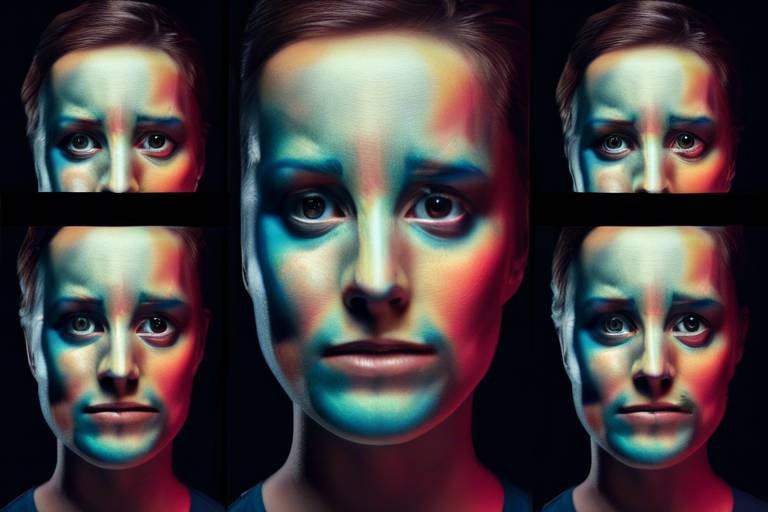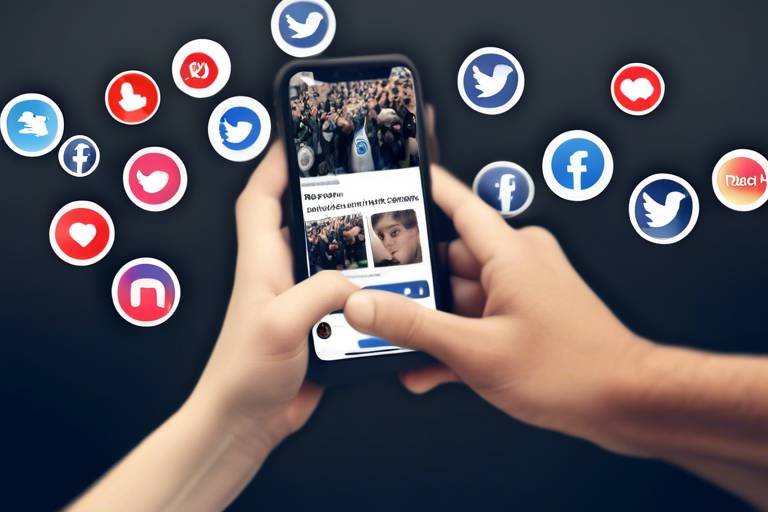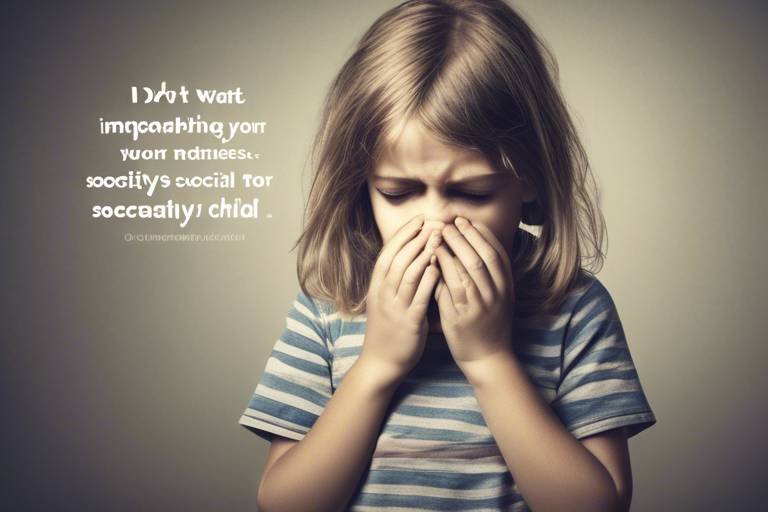Recognizing and Avoiding the Pitfalls of TikTok
In today's digital age, TikTok has captured the attention of millions around the globe, offering a platform for creativity and entertainment. However, while it can be a fun way to express oneself, there are significant pitfalls that users must recognize and avoid. From privacy concerns to mental health impacts and the spread of misinformation, the app can pose risks that are not always immediately apparent. So, how do we navigate this vibrant yet potentially hazardous landscape? Let's dive into the intricacies of TikTok, uncover its hidden dangers, and arm ourselves with the knowledge to use the platform responsibly.
The TikTok algorithm is like a secret sauce that determines what content you see and when you see it. By analyzing your interactions, it curates a personalized feed that can be incredibly engaging but also overwhelming. Understanding how this algorithm works is crucial for users who want to navigate the platform effectively. It can lead to an endless scroll of content that keeps you hooked, but sometimes, this can expose you to harmful or misleading material. Being aware of how your engagement shapes your feed can help you make more informed choices about the content you consume.
As we dive deeper into the world of TikTok, one of the most pressing issues is data privacy. With the app's popularity soaring, so too have concerns about how user information is collected and used. TikTok gathers a variety of data, from your location to your browsing habits, raising eyebrows about how this information is stored and shared. Users must be vigilant and understand the implications of their digital footprint. Are you comfortable with your data being shared with third parties? Awareness is key.
TikTok's data collection practices can feel overwhelming, but they are essential to understand. The app collects information such as:
- Your profile information
- Device information
- Location data
- Browsing history
This data is not just for internal use; it can be shared with advertisers and other third-party companies. By understanding what data is collected, users can take steps to protect their privacy more effectively.
Location tracking is one feature that can pose serious risks to user safety. By allowing TikTok to access your location, you may inadvertently expose yourself to unwanted attention or even harassment. It's crucial to be aware of this feature and adjust your settings accordingly. Always ask yourself: is it worth sharing your location for a few extra likes?
Understanding how TikTok shares data with third-party companies can empower users to make informed decisions about their privacy settings. When you sign up for TikTok, you agree to their terms and conditions, which often include clauses about data sharing. Take the time to read these terms and adjust your privacy settings to limit what information is shared and with whom.
Fortunately, there are proactive steps you can take to safeguard your personal information on TikTok. Implementing privacy settings is crucial. Here are a few tips:
- Adjust your account settings to private.
- Limit who can see your videos and interact with you.
- Be cautious about sharing personal information in your bio.
By being mindful of what you share and with whom, you can mitigate risks and enjoy TikTok more safely.
While TikTok can be a source of joy and creativity, excessive use can lead to various mental health issues. Anxiety and depression can creep in, especially when comparing ourselves to the seemingly perfect lives showcased on the platform. It's vital to recognize these impacts and take steps to maintain our well-being while using TikTok.
One major concern is body image. TikTok often promotes unrealistic beauty standards, which can negatively affect users' self-esteem. It's easy to fall into the trap of comparing ourselves to the influencers we see on our feeds. Awareness of this issue is crucial for fostering a positive self-image. Remember, the curated content you see is often filtered and edited to perfection.
The fear of missing out (FOMO) can be exacerbated by TikTok's constant barrage of trending challenges and viral moments. This social pressure can lead to feelings of inadequacy, making it essential to understand how these emotions affect your interactions. Instead of succumbing to FOMO, try to engage with content that genuinely interests you and reflects your values.
Misinformation spreads like wildfire on social media platforms, and TikTok is no exception. Users must learn to identify false information and critically evaluate the content they encounter. This is where media literacy comes into play.
Understanding how to spot fake news on TikTok is essential for informed consumption of information. Look for credible sources, check the facts, and don’t take everything at face value. It’s like being a detective in the digital world—always question the evidence before drawing conclusions.
Utilizing fact-checking resources can help users verify the information they encounter on TikTok, promoting a more informed and responsible user experience. Websites like Snopes and FactCheck.org can be invaluable tools in your quest for truth. Always remember: when in doubt, check it out!
Q: Is TikTok safe for children?
A: While TikTok can be entertaining, it’s essential for parents to monitor their children’s usage and set appropriate privacy settings to ensure a safe experience.
Q: How can I protect my privacy on TikTok?
A: Adjust your privacy settings, limit who can see your content, and be cautious about sharing personal information.
Q: What should I do if I encounter misinformation?
A: Verify the information using reliable fact-checking resources before sharing or believing it.

Understanding TikTok's Algorithm
This article explores the potential dangers associated with TikTok, including privacy concerns, mental health impacts, and misinformation, while offering practical tips for safe and responsible usage of the platform.
The TikTok algorithm is like a magician behind the curtain, pulling the strings to determine what content you see. It’s a sophisticated system that learns from your interactions, preferences, and behaviors. Imagine it as a personal assistant that knows your tastes better than you do! The more you engage with content—be it through likes, shares, or comments—the more the algorithm tailors your feed to show you videos that align with your interests. This can be both a blessing and a curse.
On one hand, it keeps you entertained by presenting you with content that resonates with you. On the other hand, it can trap you in a bubble, making it difficult to discover new perspectives or content types. For instance, if you frequently watch dance videos, the algorithm will prioritize similar content, potentially neglecting other genres that might be enriching or enlightening. Understanding this mechanism is crucial for navigating TikTok responsibly.
Here’s how the algorithm generally works:
- User Interactions: The more you engage with specific types of content, the more similar content you will see.
- Video Information: Details such as captions, sounds, and hashtags play a significant role in determining what shows up in your feed.
- Device and Account Settings: Your language preference, country setting, and device type can also influence the content you receive.
To put it simply, TikTok's algorithm is designed to keep you scrolling. It’s important to be aware of how it directs your attention and influences your viewing habits. You might find yourself spending hours on the app without even realizing it! This is why understanding the algorithm is key to maintaining a healthy relationship with the platform.
So, how can you navigate this algorithm effectively? Here are a few tips:
- Engage Mindfully: Be selective about what you engage with. If you find certain content unhelpful or harmful, scroll past it without interacting.
- Diverse Content Consumption: Actively seek out a variety of content genres to broaden your feed. This can lead to a more balanced and enriching experience.
- Regularly Review Settings: Periodically check your account settings and preferences to ensure they align with the content you wish to see.
By being proactive about your interactions and understanding the underlying mechanics of TikTok's algorithm, you can enjoy a more positive experience on the platform while avoiding content that may not serve your best interests.
With data privacy becoming a pressing issue, TikTok users must be aware of how their information is used and shared, and the implications it may have for their personal security.
TikTok's data collection practices raise significant concerns. Users should understand what data is collected and how it may be utilized to protect their privacy.
Location tracking is a feature that can pose risks to user safety. Awareness of this feature is essential for maintaining privacy while using the app.
Understanding how TikTok shares data with third-party companies can help users make informed decisions about their privacy settings and data security.
Users can take proactive steps to safeguard their personal information on TikTok. Implementing privacy settings and being cautious about what is shared can mitigate risks.
Excessive use of TikTok can lead to various mental health issues, including anxiety and depression. Recognizing these impacts is vital for maintaining well-being while using the platform.
TikTok often promotes unrealistic beauty standards, which can negatively affect users' self-esteem and body image. Awareness of this issue is crucial for fostering a positive self-image.
The fear of missing out (FOMO) and social pressure can be exacerbated by TikTok's content. Understanding these feelings can help users navigate their social interactions more healthily.
Misinformation is rampant on social media platforms, including TikTok. Users must learn to identify false information and critically evaluate the content they encounter.
Understanding how to spot fake news on TikTok is essential for informed consumption of information. Users should be equipped with the skills to differentiate between credible and unreliable sources.
Utilizing fact-checking resources can help users verify the information they encounter on TikTok, promoting a more informed and responsible user experience.
Q: How does TikTok's algorithm decide what I see?
A: TikTok's algorithm considers your interactions, video information, and device settings to curate your feed. The more you engage with specific content, the more similar content you'll see.
Q: Can I change my TikTok privacy settings?
A: Yes, you can adjust your privacy settings within the app to control who can see your content and how your data is used.
Q: What should I do if I see misinformation on TikTok?
A: If you encounter misinformation, consider using fact-checking resources to verify the information before sharing or reacting to it.

Privacy Concerns on TikTok
In today's digital age, where our lives are increasingly intertwined with technology, privacy concerns have become a hot topic, especially regarding social media platforms like TikTok. With its rapid rise to fame, TikTok has captured the attention of millions, but this popularity comes with a price. Users must be aware of how their personal information is collected, used, and potentially shared. The implications of these practices can be significant, affecting not just individual privacy but also overall security.
One of the most pressing issues is TikTok's extensive data collection practices. The app gathers a variety of information, ranging from basic user data like age and location to more sensitive details such as device information and browsing habits. This data is not only used to personalize user experiences but can also be leveraged for targeted advertising. Understanding what data is collected is crucial for users who wish to maintain their privacy. Here’s a brief overview of the types of data TikTok collects:
| Type of Data | Description |
|---|---|
| User Information | Basic info including age, email, and phone number. |
| Device Information | Data about the device you use to access TikTok, such as model, operating system, and IP address. |
| Location Data | GPS data or approximate location based on the device's settings. |
| Usage Data | Information on how you interact with the app, including video views and engagement metrics. |
Another critical aspect of privacy on TikTok is location tracking risks. Many users may not realize that the app can access their geographic location. While this feature can enhance user experience by providing localized content, it also poses a risk. Imagine sharing a video of your favorite café, only to find out that your exact location is visible to the public. This could lead to unwanted attention or even safety concerns. Users should be aware of this feature and consider disabling location services when using the app.
Furthermore, understanding how TikTok shares data with third-party companies is essential for users wanting to safeguard their privacy. TikTok, like many social media platforms, collaborates with advertisers and analytics companies. This means that your data could end up in the hands of multiple organizations. To protect yourself, it’s advisable to review and adjust your privacy settings. By limiting the information shared with third parties, users can regain some control over their data.
In conclusion, while TikTok can be a fun platform for creativity and connection, it’s vital for users to be aware of the privacy concerns associated with its use. By understanding data collection practices, location tracking risks, and third-party sharing, users can make informed decisions about their privacy settings. Ultimately, taking proactive steps to protect personal information can lead to a safer and more enjoyable TikTok experience.
- What data does TikTok collect? TikTok collects user information, device information, location data, and usage data.
- How can I protect my privacy on TikTok? You can protect your privacy by adjusting your privacy settings, disabling location services, and being cautious about the information you share.
- Does TikTok share my data with third parties? Yes, TikTok shares data with advertisers and analytics companies, which is why it's essential to review your privacy settings.

Data Collection Practices
When it comes to TikTok, one of the most pressing concerns revolves around its . Understanding what data TikTok gathers is crucial for users who want to maintain their privacy. TikTok collects a variety of information, including but not limited to:
- Personal Information: This includes your name, email address, phone number, and profile picture.
- Usage Data: TikTok tracks how you interact with the app, such as the videos you watch, the duration of your viewing, and your engagement with content.
- Device Information: The app collects data on the device you use, including your IP address, operating system, and mobile carrier.
- Location Data: If enabled, TikTok can access your GPS location, which raises significant privacy concerns.
These data collection practices are not just benign; they can have serious implications for your personal security. For instance, when TikTok collects location data, it can potentially expose users to risks, especially if that information falls into the wrong hands. Imagine sharing a video of your favorite park while unknowingly revealing your exact location to millions! This is why being aware of these practices is essential for every TikTok user.
Moreover, the way TikTok utilizes this data can vary. It’s commonly used to tailor content to your preferences, making your experience more engaging. However, this can also lead to a filter bubble, where you only see content that aligns with your existing views and interests, limiting exposure to diverse perspectives. This creates a cycle where users are continuously fed content that reinforces their beliefs, which can have broader societal implications.
To further illustrate the extent of TikTok's data collection, here's a simple table summarizing the types of data collected and their potential uses:
| Type of Data | Purpose of Collection |
|---|---|
| Personal Information | Account creation and user identification |
| Usage Data | Content personalization and advertising |
| Device Information | Technical support and app optimization |
| Location Data | Local content recommendations and advertising |
By understanding these practices, users can make more informed decisions about their privacy settings on TikTok. It's crucial to regularly review what information you are comfortable sharing and adjust your settings accordingly. Remember, knowledge is power, especially when navigating a platform as influential as TikTok!
- What data does TikTok collect? TikTok collects personal information, usage data, device information, and location data.
- How can I protect my privacy on TikTok? You can adjust your privacy settings, limit the information you share, and be cautious about the content you engage with.
- Is TikTok safe to use? While TikTok has safety measures in place, users should remain vigilant about their privacy and data security.

Location Tracking Risks
As we dive into the realm of TikTok, one of the underlying features that raises eyebrows is location tracking. This function, while designed to enhance user experience by providing personalized content, can also expose users to significant risks. Imagine sharing your favorite spots and activities while unknowingly providing strangers with your exact whereabouts! It’s a double-edged sword that can cut deep if not handled with care.
When you enable location tracking on TikTok, the app collects data that reveals your geographic location. This information can be used for various purposes, such as tailoring content to your locality or connecting you with nearby users. However, this also means that anyone with access to your profile can potentially see where you are or where you’ve been. This can lead to unwanted attention or even stalking, raising serious concerns about your personal safety.
Moreover, it's not just the app itself that poses a risk. The data collected can be shared with third parties, including advertisers and other companies. This means that your location data could end up in the hands of people who may not have your best interests at heart. Understanding how to manage these settings is crucial. Here are some steps you can take to mitigate these risks:
- Disable Location Services: If you don’t need location-based features, consider turning off location services for TikTok in your device settings.
- Be Selective with Sharing: When creating content, think twice before tagging your location. It’s better to keep your whereabouts private.
- Review Privacy Settings: Regularly check your privacy settings on TikTok to ensure that your location data is not being shared unnecessarily.
In essence, while location tracking can enhance your TikTok experience by connecting you with local trends and users, it’s essential to remain vigilant. Awareness of the risks associated with sharing your location can help you navigate the platform more safely. Remember, your safety comes first, and taking proactive measures to protect your information will allow you to enjoy TikTok without the looming shadows of privacy risks.
- What is location tracking on TikTok? Location tracking on TikTok allows the app to collect data about your geographic location to provide personalized content and connect you with nearby users.
- How can I disable location tracking? You can disable location tracking by going to your device's settings, finding the TikTok app, and turning off location services.
- What are the risks of sharing my location on TikTok? Sharing your location can expose you to privacy risks, such as unwanted attention or stalking, and your data may be shared with third parties.
- Can I control who sees my location on TikTok? Yes, you can manage your privacy settings to limit who can see your location and other personal information.

Third-Party Sharing
When it comes to social media platforms, understanding how your data is shared is crucial, and TikTok is no exception. One of the most concerning aspects of using TikTok is its practice of sharing user data with third-party companies. This means that your information, including your preferences, location, and interactions, could potentially be accessed by entities outside of the app itself. But why does this matter? Well, think of it this way: when you share a secret with a friend, you trust them to keep it private. Now, imagine that friend decides to tell someone else. That’s essentially what happens when your data is shared with third parties.
Many users are unaware that TikTok's privacy policy allows for extensive data sharing. This could include sharing your information with advertisers, analytics companies, and even business partners. The data collected can be used to create targeted advertisements or to analyze user behavior, which often leads to a personalized experience. However, this personalization comes at a cost: your privacy. To give you a clearer picture, here’s a simple breakdown:
| Type of Data Shared | Potential Third-Party Uses |
|---|---|
| User Preferences | Targeted Advertising |
| Location Data | Geographic Targeting |
| Interaction Data | User Behavior Analysis |
It's essential to be aware of how your data is being handled. TikTok may share information with third parties for various reasons, including improving their services or monetizing user data. While the platform does provide users with some control over their privacy settings, many people might not take the time to adjust these settings to minimize data sharing. This is where education and awareness come into play.
To protect yourself, consider reviewing TikTok's privacy settings regularly. You can limit the amount of data shared by:
- Adjusting your privacy settings to restrict who can see your content.
- Disabling location tracking features if they're not necessary.
- Being cautious about the information you share in your profile and videos.
Ultimately, understanding third-party sharing on TikTok is vital for maintaining your privacy. By staying informed and taking proactive steps, you can enjoy the creative aspects of TikTok while safeguarding your personal information.
Q: What kind of data does TikTok share with third parties?
A: TikTok shares various types of data, including user preferences, location data, and interaction data, which can be used for targeted advertising and user behavior analysis.
Q: Can I control what data TikTok shares?
A: Yes, TikTok provides privacy settings that allow users to limit data sharing. Regularly reviewing and adjusting these settings can help protect your information.
Q: Why is third-party data sharing a concern?
A: Third-party data sharing can lead to privacy violations and unauthorized access to personal information, making it crucial for users to be aware of how their data is being used.

Protecting Personal Information
In today's digital age, protecting your personal information is more crucial than ever, especially on platforms like TikTok. With the vast amount of data collected, it’s essential to take proactive steps to safeguard your privacy while enjoying the app. One of the first things you can do is to dive into the privacy settings. TikTok provides various options that allow you to control who can see your content and interact with you. For instance, you can switch your account to private, which restricts your videos to only your approved followers. This simple action can significantly reduce your exposure to unwanted attention and potential harassment.
Moreover, be mindful of the information you share in your profile. While it might be tempting to include your Instagram handle or other personal details, think twice about how this could affect your privacy. The more you share, the easier it is for someone to piece together your personal information. Instead, consider using a fun username that doesn't reveal your identity. Remember, anonymity can be your best friend in the vast sea of social media.
Another essential aspect of protecting your personal information is being cautious about the content you post. TikTok is all about creativity, but sharing too much can lead to unintended consequences. For example, revealing your location in a video or tagging your location can expose you to risks. Consider using general locations instead of specifics, and avoid disclosing details about your daily routine in your videos. This way, you maintain a sense of privacy while still engaging with your audience.
Furthermore, it's vital to be aware of the app's data collection practices. TikTok collects a range of information, from your device type to your browsing history. Understanding what data is collected can empower you to make informed decisions about your privacy. For instance, you can limit the app's access to your contacts and location by adjusting your device settings. This will not only protect your personal information but also enhance your overall TikTok experience.
Lastly, always stay updated on the platform's privacy policies. These policies can change frequently, and being informed about how your data is handled can help you take necessary precautions. If you notice anything concerning, don’t hesitate to voice your concerns or even reconsider your usage of the app. Remember, your safety and privacy should always come first.
- What should I do if I feel my privacy has been compromised on TikTok? If you believe your privacy has been violated, consider reporting the issue to TikTok and adjusting your privacy settings immediately.
- Can I control who sees my TikTok videos? Yes! By switching to a private account, you can control who follows you and sees your content.
- Is it safe to share my location on TikTok? It's best to avoid sharing your exact location. Instead, use general locations to maintain your privacy.
- How often should I check my privacy settings? Regularly reviewing your privacy settings is a good practice, especially after any updates to the app.

Mental Health Impacts of TikTok
The rise of TikTok has undoubtedly transformed the landscape of social media, but with great power comes great responsibility—and sometimes, great peril. As users scroll through endless videos, it’s easy to get swept away in the vibrant world of creativity and entertainment. However, it’s crucial to recognize that excessive use of TikTok can lead to various mental health issues, including anxiety and depression. The platform's design encourages users to engage continuously, which can create a cycle that is hard to break. Have you ever found yourself mindlessly scrolling for hours? You're not alone!
One significant aspect of TikTok’s influence on mental health is the promotion of unrealistic beauty standards. The app is filled with filters and editing tools that can distort reality, making it seem like everyone is living their best life and looking perfect. This constant exposure to curated content can lead to body image issues and low self-esteem among users. It’s essential to remember that what we see online is often a highlight reel, not the full story. In fact, studies have shown that social media can exacerbate feelings of inadequacy, especially among young people who are still forming their self-identity.
Moreover, the fear of missing out, commonly known as FOMO, can be intensified by TikTok’s fast-paced content. When users see their peers participating in trending challenges or attending exclusive events, it can create a sense of social pressure that is hard to shake off. This feeling can lead to anxiety, as users might feel compelled to keep up with trends or participate in activities just to feel included. Understanding these feelings is vital for maintaining a healthy relationship with social media. It’s important to ask yourself, “Am I using TikTok to connect and create, or am I feeling pressured to conform?”
To combat these mental health impacts, users can adopt several strategies. First, setting limits on screen time can help create a more balanced approach to social media use. For instance, consider using apps that track your usage and send reminders when you’ve reached your daily limit. Additionally, curating your feed by following accounts that promote positivity and self-acceptance can counteract negative influences. Engaging with content that inspires and uplifts you can make a significant difference in how you feel when using the app.
In conclusion, while TikTok can be a source of joy and creativity, it’s essential to be aware of its potential mental health impacts. Recognizing the signs of anxiety, depression, and low self-esteem can empower users to take control of their social media habits. Remember, it’s okay to take a break and prioritize your mental well-being over the latest trends. After all, your mental health is the ultimate trend worth following.
- How can I manage my time on TikTok?
Consider setting daily limits for your usage and using apps that help track your screen time.
- What should I do if I feel anxious after using TikTok?
Take a break, engage in offline activities, and talk to someone about how you’re feeling.
- How can I improve my body image while using TikTok?
Follow accounts that promote body positivity and self-acceptance, and remind yourself that social media often presents a distorted reality.

Body Image Issues
In the vibrant and often chaotic world of TikTok, users are constantly bombarded with images and videos that promote a narrow definition of beauty. This can lead to significant among viewers, particularly younger audiences who are still forming their self-identity. The platform's algorithm favors content that garners high engagement, often prioritizing videos featuring individuals who fit certain beauty standards. This creates a cycle where users are repeatedly exposed to idealized images, making it easy to fall into the trap of comparing oneself to these often unrealistic portrayals.
Many users may find themselves scrolling through their feeds, feeling increasingly dissatisfied with their own appearance. It's important to recognize that these representations are frequently edited or enhanced, leading to a distorted view of what is "normal." The pressure to conform to these standards can be overwhelming, resulting in feelings of inadequacy, low self-esteem, and even depression. In fact, studies have shown a correlation between social media use and negative body image, particularly among teenagers and young adults.
To combat these detrimental effects, users can take proactive steps. Here are a few strategies:
- Limit Exposure: Unfollow accounts that promote unrealistic beauty standards and seek out content that celebrates diversity and authenticity.
- Practice Self-Compassion: Remind yourself that everyone has flaws and that beauty comes in many forms.
- Engage in Positive Content: Follow creators who focus on body positivity and self-acceptance, helping to shift your perspective on beauty.
Moreover, it’s essential to foster an environment where discussions about body image can occur openly. Encourage friends and peers to share their experiences and feelings regarding body image and social media. This can help create a support network that promotes self-acceptance and mental well-being. Remember, it's not just about what we see on our screens; it’s about how we choose to interpret and respond to these images. By cultivating a critical eye and surrounding ourselves with positive influences, we can mitigate the harmful effects TikTok may have on our body image.
1. How does TikTok affect body image?
TikTok can negatively impact body image by promoting unrealistic beauty standards through edited and curated content, leading to feelings of inadequacy among users.
2. What can I do to improve my body image while using TikTok?
You can improve your body image by unfollowing accounts that promote unrealistic standards, practicing self-compassion, and engaging with content that celebrates body positivity.
3. Are there any resources for mental health support related to social media use?
Yes, there are numerous resources available, including mental health hotlines, online therapy platforms, and community support groups that focus on body image issues and social media impact.
4. How can I identify positive content on TikTok?
Look for creators who promote self-acceptance, diversity, and body positivity. Engaging with content that uplifts and inspires can help counteract negative feelings.

FOMO and Social Pressure
The phenomenon of FOMO—or the "Fear of Missing Out"—has become a buzzword in today’s digital age, and it's particularly pronounced on platforms like TikTok. With a constant stream of engaging content, users often find themselves scrolling through videos of friends, influencers, and celebrities living their best lives. This never-ending parade of curated highlights can create an overwhelming sense of inadequacy and anxiety. Have you ever felt that pang of jealousy when you see someone having a blast at an event you weren’t invited to? That’s FOMO in action, and TikTok amplifies it.
Social pressure, on the other hand, is the invisible hand that pushes users to conform to trends, challenges, and viral sensations. As you scroll through your feed, you might notice a catchy dance challenge or a trending hashtag that everyone seems to be participating in. It’s easy to feel like you need to jump on the bandwagon just to fit in or gain likes, which can lead to a cycle of anxiety and self-doubt. The pressure to create content that garners attention can be intense, leaving users feeling inadequate if their posts don’t receive the same level of engagement as others.
Moreover, the combination of FOMO and social pressure can lead to a toxic environment where users feel compelled to present a perfect image of their lives. This can result in a distorted sense of reality, where the highlights of others' lives overshadow one's own accomplishments. People may start to chase after experiences solely for the purpose of sharing them online, rather than for personal enjoyment. It's crucial to recognize this pattern and remind ourselves that social media often showcases a filtered version of reality.
To combat these feelings, it’s essential to take a step back and evaluate your relationship with TikTok and similar platforms. Consider the following strategies to maintain a healthy balance:
- Limit Your Time: Set boundaries on how much time you spend on the app to reduce exposure to triggering content.
- Curate Your Feed: Follow accounts that promote positivity and authenticity, and unfollow those that make you feel inadequate.
- Engage Mindfully: Instead of mindlessly scrolling, engage with content that genuinely interests you or brings you joy.
By implementing these strategies, you can mitigate the adverse effects of FOMO and social pressure, fostering a healthier relationship with social media. Remember, it’s perfectly okay to take a break and focus on your own life, rather than getting caught up in the whirlwind of TikTok trends.
Q: How can I recognize if I am experiencing FOMO?
A: If you often feel anxious or upset when seeing others’ posts, or if you feel compelled to engage in activities just to share them online, you might be experiencing FOMO.
Q: What can I do if I feel pressured to participate in trends?
A: It’s important to remember that you don’t have to participate in every trend. Take time to evaluate whether it genuinely interests you, and feel free to skip trends that don’t resonate.
Q: Is it normal to feel social pressure on social media?
A: Yes, it’s quite common. Social media often creates an environment where users feel the need to conform to certain standards or trends. Acknowledging these feelings is the first step toward managing them.

Combatting Misinformation
Misinformation is like a wildfire on social media, and TikTok is no exception. With the platform's rapid content-sharing capabilities, it’s crucial for users to develop a keen eye for spotting inaccuracies. The challenge lies not just in the sheer volume of content but also in its entertaining nature, which can sometimes overshadow the need for critical thinking. So, how can you arm yourself against the tide of misinformation? First, let's explore how to recognize fake news.
Recognizing fake news is essential for anyone who wants to navigate TikTok responsibly. Many videos may present themselves as credible information but lack proper sources. It's important to ask questions like: Is the creator citing legitimate sources? Are the claims backed by evidence? To help you discern fact from fiction, consider the following tips:
- Check the Source: Always verify where the information is coming from. Established news organizations and reputable sources are more likely to provide accurate information.
- Look for Evidence: Claims should be supported by data or credible studies. If a video makes a bold statement, see if it references any research.
- Cross-Reference: Don’t rely solely on one video or creator. Look for the same information across multiple platforms or sources.
Another effective way to combat misinformation is by utilizing fact-checking resources. Many organizations are dedicated to verifying claims made online, and using these resources can significantly enhance your media literacy. Websites like Snopes, FactCheck.org, and PolitiFact provide detailed analyses of viral claims and can help you separate fact from fiction. By integrating these resources into your TikTok experience, you can make informed decisions about the content you consume and share.
In addition to personal vigilance, it's essential to engage in conversations about misinformation with your friends and peers. Sharing knowledge about how to identify false information can create a ripple effect, encouraging others to think critically about what they see online. Remember, combating misinformation is not just an individual effort; it’s a collective responsibility. The more we educate ourselves and others, the more resilient we become against misleading content.
Finally, TikTok itself has been making strides to address misinformation. They have implemented features that flag potentially false content and provide users with additional context. Staying updated on these changes can help you navigate the platform more effectively and encourage responsible sharing practices within your community.
- What should I do if I see misinformation on TikTok? Report the content using TikTok's reporting features and share accurate information to counteract the false claims.
- How can I verify the information I see on TikTok? Utilize fact-checking websites and cross-reference the information with credible sources.
- Is it safe to share information I find on TikTok? Always verify the information before sharing. Misinformation can spread rapidly and have real-world consequences.

Recognizing Fake News
In today's fast-paced digital world, the spread of fake news has become alarmingly prevalent, especially on platforms like TikTok. As users scroll through their feeds, it’s easy to come across videos that present misinformation as fact. So, how can you tell what's real and what's just a cleverly disguised falsehood? Recognizing fake news is about developing a keen eye for detail and a critical mindset towards the content you consume.
First and foremost, always consider the source of the information. Is it coming from a reputable organization, or is it a random user with no credentials? For instance, news outlets with a history of journalistic integrity are generally more reliable than an unknown TikToker making sensational claims. Look for established news channels or verified accounts that are known for their accuracy.
Another red flag to watch out for is the emotional appeal of the content. Misinformation often plays on emotions—fear, anger, or excitement—to generate clicks and shares. If a video makes you feel a strong emotion right off the bat, it’s worth pausing and questioning the validity of the information. Ask yourself, “Does this seem too outrageous to be true?” If it does, it might be time to dig a little deeper.
Additionally, pay attention to the language used in the video. Fake news often contains sensationalized headlines or exaggerated claims that lack nuance. For instance, phrases like “you won’t believe what happened next” or “this shocking discovery changes everything” are often clues that the information may not be reliable. Instead, look for content that presents facts in a balanced and straightforward manner.
To further equip yourself against misinformation, consider utilizing fact-checking resources. Websites like Snopes, FactCheck.org, and PolitiFact are excellent tools for verifying claims and debunking myths. If you come across a piece of information that seems dubious, a quick search on these sites can help clarify the truth. Remember, it’s always better to double-check than to spread false information!
Lastly, engage with your community. Discussing content with friends or family can provide different perspectives and help you spot inconsistencies. Sharing knowledge about how to recognize fake news can create a more informed user base overall. In this digital age, we all have a responsibility to ensure that the information we share is accurate and trustworthy.
- What should I do if I encounter fake news on TikTok?
Report the content to TikTok, and consider sharing accurate information to counteract the misinformation.
- How can I verify the credibility of a source?
Check the source's background, look for reviews or ratings, and see if other reputable news outlets are reporting the same information.
- Are there specific signs that indicate fake news?
Yes, be wary of sensational language, lack of citations, and emotional manipulation. If it seems too good or bad to be true, it probably is.

Fact-Checking Resources
In today's digital age, where information spreads like wildfire, are more crucial than ever, especially on platforms like TikTok. With a plethora of content being uploaded every second, it can be challenging to discern what’s accurate and what’s simply noise. Thankfully, there are several reliable resources that can help users sift through the clutter and verify the information they come across.
One of the most effective ways to combat misinformation is to utilize reputable fact-checking websites. These platforms specialize in investigating claims and providing users with the truth behind viral content. Some well-known fact-checking organizations include:
- Snopes: This site is a pioneer in debunking myths and rumors, offering detailed investigations into viral stories and claims.
- FactCheck.org: A project of the Annenberg Public Policy Center, it focuses on political claims and provides nonpartisan analyses.
- PolitiFact: Known for its Truth-O-Meter, PolitiFact checks the accuracy of statements made by politicians and public figures.
- Full Fact: A UK-based organization that fact-checks claims made in the media and by politicians, providing clear explanations and sources.
These resources not only help users verify the authenticity of information but also educate them on how to critically evaluate content. For instance, when encountering a sensational claim on TikTok, users should ask themselves:
- Is the source credible?
- What evidence is provided to support the claim?
- Are there other reputable outlets reporting the same information?
Moreover, many of these fact-checking platforms offer browser extensions or mobile apps that can provide instant verification while you browse. This means that you can quickly check the validity of a claim without leaving the TikTok app. Integrating these tools into your daily routine can significantly enhance your media literacy and empower you to make informed decisions about the content you consume.
In addition to these resources, it's also beneficial to engage with the community. Many TikTok users are becoming increasingly aware of misinformation and are actively sharing tips and resources to combat it. By following creators who emphasize the importance of fact-checking, you can stay updated on the latest tools and techniques for verifying information.
Ultimately, the responsibility lies with each user to cultivate a discerning eye. By leveraging fact-checking resources and fostering a habit of skepticism, you can navigate TikTok—and the broader social media landscape—more safely and intelligently. Remember, a well-informed user is a powerful user, capable of making smarter choices and contributing to a more truthful online environment.
Q: How can I tell if a TikTok video contains misinformation?
A: Look for credible sources, verify the claims using fact-checking websites, and check if other reputable news outlets are reporting the same information.
Q: Are there specific fact-checking apps I should use?
A: Yes, apps like Snopes and FactCheck.org have mobile-friendly versions that you can use to verify claims quickly.
Q: What should I do if I find misinformation on TikTok?
A: Report the content on TikTok, share accurate information, and encourage others to fact-check before sharing.
Frequently Asked Questions
- What are the main privacy concerns associated with TikTok?
Privacy concerns on TikTok primarily revolve around data collection practices, location tracking, and third-party sharing. Users should be aware that TikTok collects various data points, including location information and usage patterns, which can potentially be shared with advertisers and other third parties. Understanding these practices is crucial for protecting your personal information while using the app.
- How can I protect my personal information on TikTok?
To safeguard your personal information on TikTok, consider adjusting your privacy settings. This includes limiting who can see your content, disabling location tracking, and being selective about what personal information you share in your profile. Regularly reviewing your privacy settings can help mitigate risks and enhance your security on the platform.
- What mental health impacts can arise from using TikTok excessively?
Excessive use of TikTok can lead to mental health issues such as anxiety, depression, and body image concerns. The platform often showcases unrealistic beauty standards and can create feelings of FOMO (fear of missing out) and social pressure. It's essential to be mindful of your usage and take breaks when needed to maintain your well-being.
- How can I recognize misinformation on TikTok?
To spot misinformation on TikTok, look for credible sources and cross-check the information with reliable fact-checking websites. Be skeptical of sensational claims and seek out content that provides evidence or references. Developing a critical eye for content will help you navigate the platform more safely.
- Are there resources available for fact-checking information found on TikTok?
Yes, there are several fact-checking resources available online that can help verify information found on TikTok. Websites like Snopes, FactCheck.org, and PolitiFact are great places to start. Utilizing these resources can promote a more informed and responsible user experience on the platform.



















